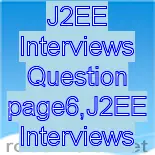J2EE Interviews Question page6
- What is Enterprise JavaBeans (EJB) ?
A component architecture for the development and deployment of object-oriented, distributed, enterprise-level applications. Applications written using the Enterprise JavaBeans architecture are scalable, transactional, and secure.
-
What is Enterprise JavaBeans Query Language (EJB QL) ?
Defines the queries for the finder and select methods of an entity bean having container-managed persistence. A subset of SQL92, EJB QL has extensions that allow navigation over the relationships defined in an entity bean's abstract schema.
-
What is an entity ?
A distinct, individual item that can be included in an XML document by referencing it. Such an entity reference can name an entity as small as a character (for example, <, which references the less-than symbol or left angle bracket, <). An entity reference can also reference an entire document, an external entity, or a collection of DTD definitions.
-
What is entity bean ?
An enterprise bean that represents persistent data maintained in a database. An entity bean can manage its own persistence or can delegate this function to its container. An entity bean is identified by a primary key. If the container in which an entity bean is hosted crashes, the entity bean, its primary key, and any remote references survive the crash.
-
What is entity reference ?
A reference to an entity that is substituted for the reference when the XML document is parsed. It can reference a predefined entity such as < or reference one that is defined in the DTD. In the XML data, the reference could be to an entity that is defined in the local subset of the DTD or to an external XML file (an external entity). The DTD can also carve out a segment of DTD specifications and give it a name so that it can be reused (included) at multiple points in the DTD by defining a parameter entity.
-
What is error ?
A SAX parsing error is generally a validation error; in other words, it occurs when an XML document is not valid, although it can also occur if the declaration specifies an XML version that the parser cannot handle. See also fatal error, warning.
-
What is Extensible Markup Language ?
XML.
-
What is external entity ?
An entity that exists as an external XML file, which is included in the XML document using an entity reference.
-
What is external subset ?
That part of a DTD that is defined by references to external DTD files.
-
What is fatal error ?
A fatal error occurs in the SAX parser when a document is not well formed or otherwise cannot be processed. See also error, warning.
-
What is filter ?
An object that can transform the header or content (or both) of a request or response. Filters differ from Web components in that they usually do not themselves create responses but rather modify or adapt the requests for a resource, and modify or adapt responses from a resource. A filter should not have any dependencies on a Web resource for which it is acting as a filter so that it can be composable with more than one type of Web resource.
-
What is filter chain ?
A concatenation of XSLT transformations in which the output of one transformation becomes the input of the next.
-
What is finder method ?
A method defined in the Interview Questions - Home interface and invoked by a client to locate an entity bean.
-
What is form-based authentication ?
An authentication mechanism in which a Web container provides an application-specific form for logging in. This form of authentication uses Base64 encoding and can expose user names and passwords
-
What is general entity ?
An entity that is referenced as part of an XML document's content, as distinct from a parameter entity, which is referenced in the DTD. A general entity can be a parsed entity or an unparsed entity.
-
What is group ?
An authenticated set of users classified by common traits such as job title or customer profile. Groups are also associated with a set of roles, and every user that is a member of a group inherits all the roles assigned to that group.



